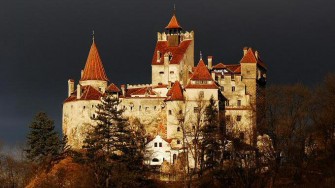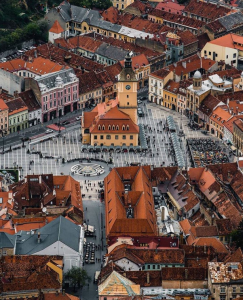Brasov- land of Transylvania
The city of Brasov, the county seat of the same name, is located exactly in the center of the country, in the Depression of Brasov, at an altitude of 625 m. Brasov was mentioned documentally, for the first time in 1235 under the name of Corona, as a settlement in which the being a monastery of the catholic religious order premonstratens. The beginnings of the history of the city are, however, earlier with several decades, being related to the German colonization in the region and to the donation of Barsa Country, made by King Andrew II of Hungary of the Teutonic Knights, in 1211, the locality being founded immediately thereafter, most likely in 1213.
Brasov can be proud of its world uniqueness, being the only city in the world that includes in its administrative territory a natural reserve - Tampa Nature Reserve and a mountain peak - Postavaru Peak (1799 m). The city now surrounds Mount Tampa, Sprenghi Hill, Morii Hill, Melcilor Hill, Warthe Hill, Cetatii Hill or Straja and Romuri Hill, but also Stejarisul, its extent being worthy of a large European tourist city.
Culturally and historically, the city of Brasov has had a special development, being an amalgam of cultures and nationalities. The old Romanian, Saxon and Hungarian culture blended perfectly, the city always being in step with the economic, social and cultural development of the whole world. In addition to Romanians, Germans (Saxons) and Hungarians (and Szeklers), Brasov was also home to communities larger or smaller than Gypsies, Jews, Greeks, Bulgarians, Czechs, Slovaks, Russians or Italians.
Today's city was formed by uniting several cores that appeared over time on the place of Brasov today: Bartolomeu, Martinsberg, the Fortress or the Crown, Schei, Blumana, Noua, Darste, Honterus (it is in the Astra district of our day). , Stupini.
The Country of Barsa (Brasov and its vicinity), played an important role in the Middle Ages, having three strategic points that ensured its economic, military and political development: The first is the Fagaras Fortress, the region being known as the Fagaras Land, which for a long time was under Romanian administration, preserving the old customs of the land, and is also a safe place in Transylvania for the rulers of the Romanian Country.
The second point is Bran Castle, (located 30 km from Brasov on the European road E 574 towards Piteşti), at present being the whole museum hosting three permanent exhibitions: one in the castle, the second in the Ethnography Museum (outdoors), and the third in the old customs building.

The third point is Brasov, first documented in 1235, the most important city in Transylvania during the Middle Ages, an economic fortress in the 14th-16th centuries. Most of the villages inhabited by Saxons (Germanic population colonized in the 12th century in Transylvania) keep fortified churches, places of prayer and shelter. The largest church - fort in Brasov county is located in Prejmer, but the ones from Viscri and Homorod are equally interesting.
The Black Church of Brasov
The Black Church is one of the most representative Gothic buildings in our country, its erection being realized in the XIV-XV centuries. It is considered the largest church in Romania, being also the largest Gothic style place of worship in south-eastern Europe, receiving, at the time of its inauguration, the title of "The largest church between Vienna and Constantinople", that is from St. Stephen's Dome from Vienna to Hagia Sophia in modern-day Istanbul.

In 1383 the construction of the current church began, at a time when Brasov was experiencing a period of flourishing cultural and economic development, being the most important urban development on the border of Transylvania with the Romanian Country. The Black Church is noted, as I mentioned, and by the largest bell in the Romanian space, bronze, which weighs about 6 tons, and except for the Topkapi Museum in Istanbul, the Black Church has the largest collection of oriental carpets in Europe, dating from the 15th to the 16th centuries.



